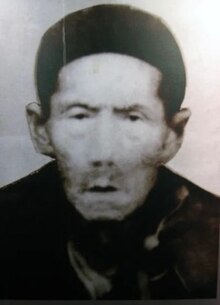You can help expand this article with text translated from the corresponding article in Chinese. (February 2024) Click for important translation instructions.
|
| Liangqing (良卿法师) | |
|---|---|
 | |
| Title | Abbot |
| Personal life | |
| Born | 1896 Yanshi County, Henan, Qing dynasty (today China) |
| Died | 12 July 1966(1966-07-12) (aged 69–70) Famen Temple, Famen town, Fufeng County, Shaanxi, China |
| Nationality | Chinese |
| Occupation | Monk |
| Religious life | |
| Religion | Buddhism |
Liangqing (良卿法师) was a Chinese Buddhist monk and abbot of Famen Temple (Chinese: 法门寺; pinyin: Fǎmén Sì).
At the beginning of the Chinese Cultural Revolution in 1966, a campaign was introduced to destroy the Four Olds. As Buddhist sites and temples were widely targeted during this campaign, Liangqing's Famen Temple was a major target for destruction. Hundreds of Red Guards were sent to destroy the Famen Temple. Due to this imposing threat, Liangqing, the temple's Abbot, chose an act of self-immolation to protect the temple and contents from destruction. Although the contents of the temple were all smashed by the Red Guard, Liangqing's self-sacrifice was successful as the temple's True Relic Pagoda and its relic of the Buddha were both saved from destruction.
References
- "Archived copy" (PDF). Archived from the original (PDF) on 2013-01-21. Retrieved 2013-01-12.
{{cite web}}: CS1 maint: archived copy as title (link) - china.org.cn: China-s Buddhist Mecca (archived)
- thetibetpost.com: Chinese Author Hu Ping Analyses Tibet Self-Immolation Actions Archived 2012-12-30 at the Wayback Machine
This Buddhist biography-related article is a stub. You can help Misplaced Pages by expanding it. |
This Chinese religion-related biographical article is a stub. You can help Misplaced Pages by expanding it. |
- 1896 births
- 1966 suicides
- 1966 deaths
- Buddhist abbots
- 20th-century abbots
- 20th-century Chinese people
- Suicides during the Cultural Revolution
- 1966 in China
- Self-immolations by Buddhists
- People from Yanshi
- Qing dynasty Buddhist monks
- Chinese Buddhist monks
- Buddhist martyrs
- Rinzai Buddhists
- 20th-century Buddhist monks
- Buddhist biography stubs
- Chinese religious biography stubs